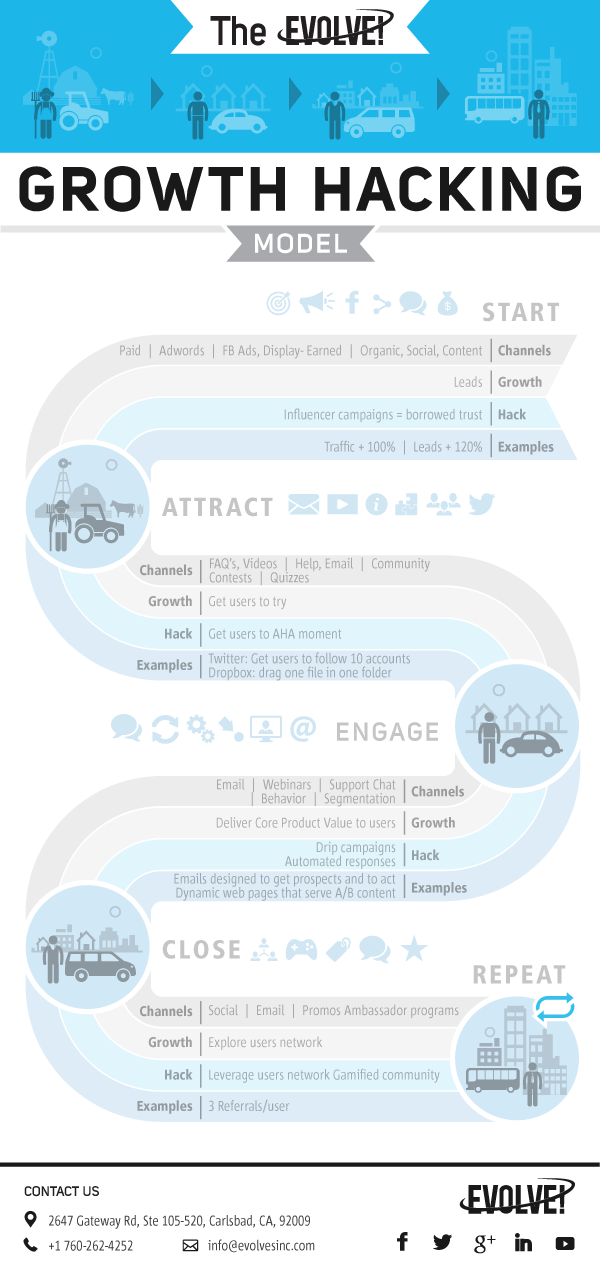At Evolve! we’re constantly on the lookout for what I call Andy Johns growth hacks for our clients. If you don’t know Andy, you should follow him online. I also wrote about him on Forbes here. Much of what we learned and developed into a model, was developed from Johns’ insights from Facebook, Twitter and Quora.
The goal for growth hacking is to conduct growth experiments with user acquisition until we find tactics that bring in leads and revenue at a low cost (at least that’s our goal).
We’ve been at it for a few years now and have discovered a process that helps define the road map for growth hacks that work. You can see them down below in the infographic, but I want to list them out for you as a guide with my personal commentary so that I can better illustrate the concepts.
There are four primary stages we use. The first is the Attract phase, the second is the Engage phase, Close is the third and finally Repeat is the last phase. This whole process repeats until we optimize the campaign, tactic or project.
Let’s jump right in and cover the start of our growth hacking journey:
UNDERSTAND YOUR OBJECTIVES AND PERSONAS
Don’t start growth hacking unless you have a very good understanding of what you want to achieve and who you want to achieve it with. For some, this may sound obvious, but in our experience most companies don’t have this down yet.
Objectives, like “we want to increase web traffic by 20% every month for the next 12 months” help set the expectation for what will become your growth team. Customer personas give you a person(s) to target. A fictional person that represents an average set of demographics of a particular audience segment.
Your Growth Hacking team can be a single individual or a full team like you see at Facebook or Quora.
- ATTRACT NEW CUSTOMERS THROUGH CLEVER CAMPAIGNS
Depending on your target audience, there are many methods to encouraging prospective customers to either try your product or sign up for your email list. The key is to experiment until you find the right triggers that encourage people to take the action you want them too.
For example, Twitter found that if a user followed 10 accounts, that user was much more likely to return and use Twitter. So as part of the onboarding process, Twitter encouraged users to follow 10 – 50 people right off the bat. Of course those people were interesting or celebrities, so that helped with engagement.
Another example, at Evolve! we ran a sports quiz that encouraged people on social media to take a quiz about how much they knew the sports subject. The campaign brought in thousands of prospective customers (based on our persona work above) that we knew loved sports and thus, were more likely to buy our client’s product.
Pro Tip: One of the keys to success was to observe the most active users and study their patterns. Then, create experiences for new and existing users that encourage them to fall into those same patterns.
- ONCE THEY ARE SIGNED UP ENGAGE THEM
In my experience, well over 75% of companies that have an email database are either not regularly reaching out to their prospective customers or worse are completely ignoring them. One of the easiest ways to engage your prospective customers is to create a series of drip campaigns that are designed to get prospects to act.
These drip emails should go out on a regular schedule and should be used to:
- The emails should have a personal tone, friendly and helpful
- Ask them to join your Facebook community or follow you on social networks
- Include product or service updates
- Send special offers (like coupons, discounts, offers) to your email subscribers
- Offers to download ebooks, attend a webinar, participate in a tweet jam – essentially anything that moves that prospect through the buyer journey.
While email is our favorite way to engage current and future customers, we also recommend you use a solution like Intercom which allows you to engage people on your website in real time. Use the lessons of email above, but you can also help the prospect through your website to achieve their goals. This isn’t necessarily customer support, this is customer engagement.
Pro Tip: Once you have mastered email and chat, build user buying sequences through your website in order to maximize revenue opportunity. For example, if you know that when 70% of the time, persona A visits your web pages X, Y and Z they make a purchase, then whenever persona A is on your website, you make sure they see web pages X, Y and Z.
- CLOSE: ONCE THEY BECOME CUSTOMERS/USERS TURN THEM INTO ADVOCATES
Note, not all of your customers or users will become advocates of your company or product, but in our experience 10% will if you or your product resonates with an audience (this can be true even before a new product is launched).
So how do you segment out the advocates from everyone else?
We like to survey our database with a single question. “On a scale of 1 – 10, how likely are you to recommend our product/service to your friends?” For anyone that answers 8 or higher, we invite them into a gamified community. What is a gamified community? Influitive is one, Lithium is another.
Gamified communities reward advocates for helping the company promote content, answer surveys, or ask friends to try or buy the company’s product. For example, Paypal used to pay a user $5 for every referral that signed up.
Pro Tip: There are several growth hacks at this stage that involve marketing, or product or packaging. The trick is to find the right motivators that will get your customers to take action. We like gamification because our client’s customers can spend the points on prizes they want.
- Rinse and Repeat
Once you’ve attracted a community, continue to build that community around a cause or ideology. Continue to run campaigns by starting back at step 1, segment and engage your users in step 2, and nurture the new members of your community in step 3.
Expect to fail a lot, but take note of the campaigns, tactics and hacks that work. In time, you’ll be building an engaged community that will help you sell your products and services for you.
Pro Tip: Measure everything, but use a combination or intuition and analytics to try new campaigns and hacks. Then, see what drives the most desired behavior and keep those while shedding the ones that don’t work.
Have you developed your own model? Please share your insights below in the comments.


